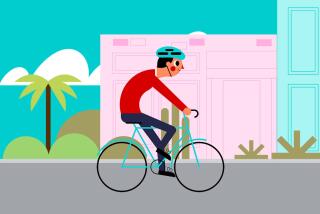Taking your bike on a road trip? Here’s what you need to know about racks
- Share via
Don’t smash the bikes!
That printed admonition was taped across the dashboard of our vehicle during last summer’s 3,200-mile Pacific Northwest excursion.
Hey, anything to take care of the “kids.”
Sure, you can throw a blanket on the trunk and strap your bikes with bungees, but it’s best to use a rack. You’ll find several options for cars, vans and trucks; hitch and roof racks the two leading methods.
“People focus on all the stuff they need to pack [for a trip] and all the places they are going to ride, but they don’t think enough about how it is they are transporting their bikes,” said T.J. Jordan, owner of Hub Cyclery in cycling-mad Bend, Ore.
He gives a thumbs-up to tire-securing hitch systems, notably those by Kuat.
Jordan is no stranger to transit-damaged bikes.The day we spoke he was replacing a wheel for a woman who had gone through a drive-through with her bike on the roof rack.
A hitch rack, affixed to a trailer hitch, are the best and easiest option said Jonny Wood, brand manager for Yakima, one of the largest makers of racks. “The racks are easy to take on and off the hitch,” he said, “and you’re loading bikes at waist height instead of over your head.”
In their most basic form, these racks consist of two posts that extend from a vertical frame. The top (horizontal) tube of the bike is placed over the posts and held in place by straps. A typical rack holds two to four bikes.
A more advanced hitch rack consists of a fold-down mechanism that has perpendicular “trays.” The bikes’ wheels sit in the trays and are held in place by several mechanisms. The most common is an “arm” that extends over one of the tires while the other is held in place by a ratcheted strap.
Some models forgo the tire hold for a hand-like clasp that holds the bike frame. (Check with your bike manufacturer about the warranty implications of using a particular kind of rack — typically the frame hold.)
“We feel hitch-mounted racks have proved the best option for us over the years,” said James Bellerue, designer and painter with Santa Barbara-based Stinner Frameworks, crafters of high-end custom steel and titanium bikes. “They check all the boxes.”
Roof versus hitch
Roof systems offer an array of options to secure bikes, and most have interchangeable mounts (at an additional cost) for skis, cargo boxes, canoes and kayaks.
These racks easily accommodate two bikes; three or four isn’t much of a problem on a car of appropriate size. If you’ve ever seen what’s on the roof of one of the team cars in the Tour de France, you might suspect the Von Trapp family was competing.
The downside: A roof rack can take a bite out of gas mileage and can be noisy if it lacks a wind-diverting flap below the front crossbar.
You also must lift the bikes to load them, which can be a drawback if you’re short or lack upper-body strength. At cycling events participants often stand on a footstool or stepladder to load and unload their bikes.
And last but not least: Roof racks require drivers to pay attention to what is overhead.
This is not a time to get cheap. You love your bikes and could have thousands invested in each one.
Racks can cost about $100 for a simple hitch unit to $500 or more for elaborate systems, but you’ll use it for years.
Oh, you’re just hauling the family cruisers? What is your insurance carrier going to say if your bailing-wire approach puts Joey’s Huffy through the grill of the Subaru behind you?
“We’re all veterans of bike-shop life,” said Bellerue, “so unfortunately we’ve seen our fair share of rack disasters. Everything should be great as long as you focus on what you’re doing and follow the directions.”
More to Read
Sign up for The Wild
We’ll help you find the best places to hike, bike and run, as well as the perfect silent spots for meditation and yoga.
You may occasionally receive promotional content from the Los Angeles Times.




